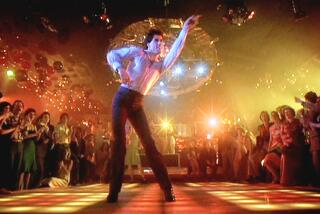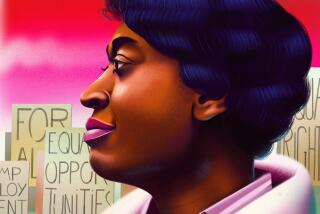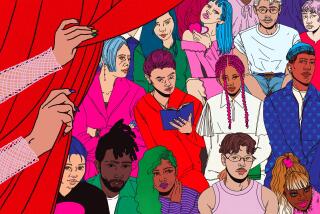Circling the Square
THERE are other writers as intelligent as Marshall Berman, and as able to draw together disparate elements of cultural history into a dazzling new picture, but they seldom sustain the same sense of compassionate warmth toward those who make history. This is why Berman’s scarce production has been cause for regret and a new book cause for excitement -- in this case his “On the Town: One Hundred Years of Spectacle in Times Square.” This is a book that makes you forgive New York’s cosmopolitan parochialism and then regret that the West has never quite achieved that degree of urban life.
A New York native and a professor of political theory and urban studies at City University of New York, Berman made waves almost a quarter-century ago with “All That Is Solid Melts into Air: The Experience of Modernity,” a book that synthesized literature, politics and the workings of cities into a grand thesis that begins with Goethe’s “Faust” and ends with American cities in the 1970s. Since then, readers have had nothing but individual essays (and an anthology of them, “Adventures in Marxism”) by Berman, though some of these are landmarks themselves.
Writers are always turning this place and that incident into microcosms for the whole polity or society, but in “On the Town” Berman makes a stellar case for Times Square, tracing it from its showbiz and advertising beginnings through its golden years, its decline into a seedy porn zone and its recent revival as a generic play zone for Disney and MTV. Times Square is both a real place where millions of people have wandered and a symbolic space that appears in films, photographs and plays.
If anything in the West approximates it, it’s the Las Vegas Strip, with dazzling spectacle one can pay for or just enjoy as part of the milling throng on the pedestrian street. But the Strip has never had the vitality, the sense of being part of the larger hive of urban life that Times Square once had -- the mix of commerce and citizenship. Berman provides a history of the literal, physical Times Square -- of signs, architecture and street life in the actual place -- and of plays, movies and other entertainments reflecting the meaning of the place to a broader public.
“In its century of life,” he claims for Times Square, “it has taken one of the primal urban experiences -- being in the midst of a physical and semiotic overflow, feeling the flow all over you -- and concentrated it and focused it and sped it up and blown it up. The signature experience of being there is being surrounded by too many in the midst of too much. Rem Koolhaas calls it ‘Manhattanization’ or ‘The Culture of Congestion.’ It is loved all over the world. It gives people a thrill, a rush, a power surge from being there.”
Sex is everywhere in this experience, in the advertisements, the glances of strangers, the brush of bodies against one another in the crowd. What is perhaps most important in the book remains always implicit: that this erotic desire lures people into public where they come to meet, to see one another, come to feel that they live in a community, that they have something in common with strangers. This sense of belonging to the crowd is pivotal to democracy (as is the ability of this crowd to act pivotal to urban revolution, another kind of exhilaration that never quite enters into Times Square). Thus, you could argue, sex is crucial to democracy; there is an eros of public life. It’s not about anything as concrete as physical intimacy; it’s about a much more pervasive possibility of encountering, connecting and generating, for a city is reborn every day through the acts of its citizens. Otherwise, it would be dead buildings and streets.
And the mingling here isn’t just of men and women, but of fancy and gritty, rich and poor, immigrants and aristocrats. When stripper Gypsy Rose Lee arrived in Times Square in 1931, during the Depression, she found hot dog stands, Fred Astaire performing live, burlesque and mainstream theaters -- a scene that was immortalized in “Guys and Dolls.” (Berman gives us both Gypsy and “Guys and Dolls” as part of his tour.)
There is a long history of men reading the city as a woman. Surrealists like Andre Breton, Louis Aragon and Philippe Soupault all portrayed Paris as a female beloved whom the writer and walker explores as a lover. In one of Berman’s most surprising readings (surprising in part because it reveals this Marxist intellectual kept up with the upscale consumer-palooza that was “Sex and the City”), the author turns the tables on this old formula when he cites Carrie Bradshaw telling an anti-urban sailor on leave, “If you only get one great love ... then New York may well be mine.... “
Much of this history unfolds for Berman in movies that include “The Jazz Singer,” “42nd Street” and “Taxi Driver,” and in musical detours with Bob Dylan, Liz Phair and others. But a key passage in his book has to do with his parents, who worked in the garment industry just off Times Square and who would go back there for a night on the town -- a show and a tryst in a hotel -- even after their kids were born. Times Square represented for them, among other things, the place where they left behind the ghetto of the Lower East Side to take up citizenship in New York City as a whole.
Later, as Berman was growing up in the Bronx, his widowed mother would take her kids to the Square, saying, “Now we’re going to take a bath in light.” Berman describes the changes of Times Square with an unusual sensitivity to women’s roles in public life, so that the book becomes an oblique history of women in the United States written in neon signs, billboards and sidewalk mores.
A pivotal chapter opens, “The two most famous people in the history of Times Square are anonymous. They are a man and woman locked in each other’s arms. They were part of the enormous crowd that gathered in the Square on August 15, 1945, V-J Day, the day and night of Japan’s surrender and the end of World War Two.” A live swing band, perhaps Artie Shaw’s, began to play, thousands of men and women began to dance with one another. “Two of them, a sailor and a nurse, locked in a rapt embrace at the very center of the Square, became the subjects of a great photograph. It was taken by the German Jewish refugee photographer Alfred Eisenstaedt, and it ran on the cover of Life magazine.”
Here is eros in public as an antithesis to war or as war’s triumph. And here is a moment between two people that became a magazine cover, and as an American icon, Times Square became ubiquitous. But in the late 20th century, the ideal suggested by this embrace disappeared: “[T]hat sailor and that girl got split up,” Berman writes. “Times Square, over most of the twentieth century, created an ambience where women could be not only commercial sexual objects but, at the same time in the same place, authentic human subjects. But then things happened that wrecked the place’s remarkable inner balance.”
Berman is sympathetic to women throughout this book, but he doesn’t always seem to recognize that even as some women triumphed, others were intimidated and limited in dozens of ways even before Times Square turned into a sleazy, men-only zone in the 1970s and 1980s (his celebration of comic Dave Chappelle in 2004 complimenting women in Times Square on their breasts is a low point of the book). Berman’s attack on Laura Mulvey’s landmark feminist essay on “the male gaze” misses Mulvey’s overstated but important point: that films depict the world from a male point of view and transform women into nonthreatening spectacles.
But from there Berman recovers his balance with analysis of what turns out to be yet another Times Square movie, Martin Scorsese’s 1976 “Taxi Driver,” with its detours through a porn theater and child prostitution and its baths of rainy light.
The recent history of the Square is not its best, but Berman does like its new digital and electronic signs -- though not as much as he likes the teenagers hanging out by the MTV studios. “I’m pretty suspicious of the discourse of nostalgia, including my own,” writes this professor in his 60s. “I find today’s exploding lights and multicultural crowds as hot and sexy as any I’ve ever known, if people would only stretch themselves to look and feel.”
Berman ends with a benediction of sorts as befits a rabbinical revolutionary who’s spent a whole life in New York: “Let badness be recognized with goodness as part of Times Square’s essential life, so that the Square can be once more what we know it always has been, a chupah for the marriage of heaven and hell.” Perhaps, but the sense that Times Square matters cosmologically is gone, and with it fled something of the promise of cities. *
More to Read
Sign up for our Book Club newsletter
Get the latest news, events and more from the Los Angeles Times Book Club, and help us get L.A. reading and talking.
You may occasionally receive promotional content from the Los Angeles Times.






